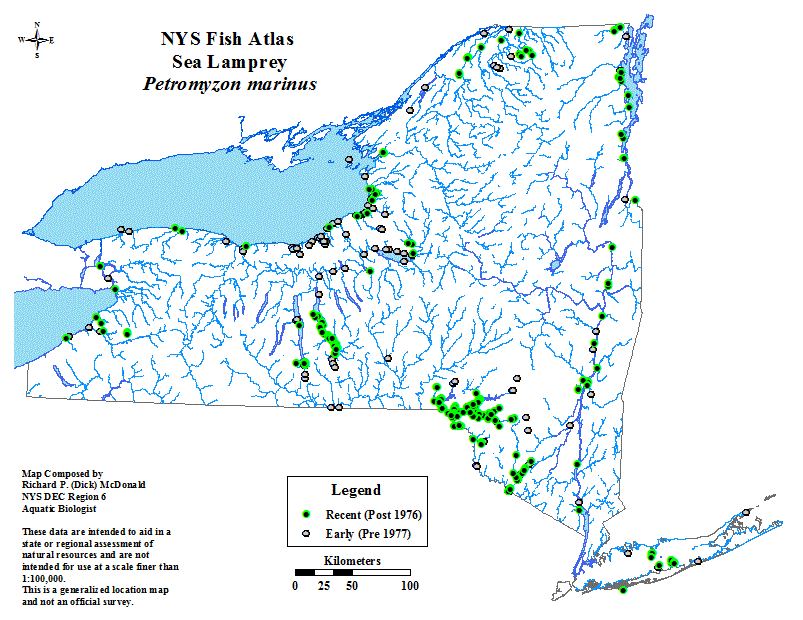
Sea Lamprey (Petromyzon marinus)
The sea lamprey is one of the most primitive freshwater fishes existing in New York. This fish, because of its eel-like shape, is sometimes called a lamprey eel, but it is not an eel at all. Lampreys have no jaws, and their skeleton is cartilaginous.
The sea-run form of the lamprey is found regularly and extensively in the Hudson, Delaware, and lower St. Lawrence rivers. It also occurs on the periphery of Long Island. Inland, it is present in Lake Ontario, Lake Champlain, Oneida Lake, Cayuga Lake, and Seneca Lake.
A key characteristic of this fish is its round, suckerlike mouth, lined with concentric rings of teeth. Its tongue also has raspy teeth. These mouth structures are not without purpose, as the adult sea lamprey is a parasitic creature, feeding on the blood and body fluids of other fish. By using its sucker mouth to attach itself to the side of a fish, the lamprey tears away the fish's protective covering (scales and skin). Blood and other body fluids of the host fish are then ingested by the lamprey. A continuous flow of blood is ensured by the secretion of an anticoagulant produced by special glands in the lamprey.
If not landlocked, sea lampreys spend their adult life in the ocean. They return to fresh water to spawn (that is, they are anadromous), migrating up streams in May and early June. Males build nests in shallow, swift water by removing cobble and forming a depression on the stream bottom. It is from this characteristic that it gets the scientific name petromyzon, which means "stone sucker." After the male releases her eggs and the male fertilizes them, both adults drift downstream and die.
Several days later, tiny young lampreys called ammocoetes leave the nest and drift downstream to shallow areas that have little current and a mud bottom. There they burrow into the mud. These larvae are nonparasitic and feed on organic material filtered from the water. In 3 to 14+ years, they reach a length of 5 to 7 inches and transform into the adult stage. These new adults move down the streams and out to sea. Upon returning on their spawning run, they will be 2 to 3 feet long. Sea lampreys are important in New York because of the damage they cause to other desirable fish. Considerable effort has been made to reduce lamprey populations in the larger inland lakes. In these areas they cause extensive damage to sport fisheries.
Distribution of sea lampreys in NY state.
An image of the sea lamprey is also available for download.
